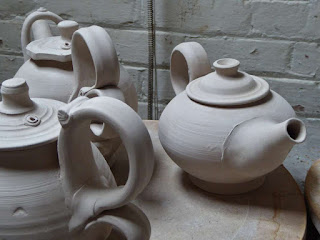Teapots With Loopy Handles!
These teapots are quite large, I am guessing they will hold 6 good sized cups of tea, all are made from a high fired porcelain clay. I measure the tops with calipers and throw a lid to fit the hole provide! The lids were thrown from a large single mound of clay on the potter's wheel; they are made in one piece upside down.
At the beginning of the second day I throw spouts on the wheel and make handles. The spouts are really bottomless cylinders that have been pulled in to form a cone shape. The handles were pulled with wet hands from a large carrot shaped handful of clay, and bent into an approximation of their final handle shape when they were put onto a ware board. The spouts and handles need to dry for an hour or two so that they are stiff enough to join to the teapot.
Whilst the handles and spouts are stiffening up I fit the lids to the teapot bodies, then centre each teapot body on the potter's wheel. I put some blobs of clay around the foot of the pot to hold it in place on the wheel, then I turn away the surplus clay from the lid with a wire loop tool, to refine the form and to make the knob on the top. This part of making the pot is a little bit like wood turning, in that you are starting with surplus material, and then peeling away the waste to find the form within.
When the lids are finished it is time to fit first the spouts, then the handles. One day I must take some photos of fitting spouts. In brief it is a question of flattening the area where the spout is to be fitted, then the base of the spout is trimmed at a sloping angle, and the spout is offered up to the teapot body to test the fit. I usually score a little line around the place where spout meets the teapot body, then take the spout off again and put it in a safe place whilst I do the next operation on the teapot which is to bore a grid pattern of little holes through the body with a special tool. The small holes form a filter to the spout that helps stop tea leaves ending up in your cup of tea. Once the filter is finished I score both the teapot body and the base of the spout before joining them with a little slip or water to help them stick together.
Then a handle is selected from the rough handles that I pulled early in the day. I like to have extra handles on hand so that I can pick and choose. Handles for large teapots present an engineering problem. If they are positioned right at the back then the weight of the full pot is hard to hold onto, I like to bring mine up and as far forward as I can so that the hand has more control.
This simple loop style works quite well. I first attached a stub of clay to the teapot body, then attached the top end of the handle to it, this helped bring the handle up and further forward.
On another teapot I played with having a second smaller loop under the first. This loop adds strength to the top loop.
Sometimes I add a coil of clay to a handle to give more grip.
I also have been known to put another handle on the front of a teapot, so that two hands can hold the pot when pouring. The front handle can work very well.
I like making teapots with handles that go right over the top of the pot, we often use one of these ourselves to make tea, but many people seem reluctant to try them, and ask for a handle at the back.
All the teapots have been bisque fired now, and will probably wait for my next wood firing for their glaze firing.












Comments
I couldn't agree more!
Looking forward to seeing these glazed.
Lovely to hear from you, I can handle something punny....(groan!) at any hour! Ah, the awful tea in canteen teapots, I suffered mightily from that affliction whilst working in a supermarket many years ago. As the youngest in the fruit and veg department, I was given the earliest lunch break (11.30am) and the latest afternoon tea, which I would take after unloading a truck full of veges. Often this was nearly 3.30, and the tepid tea had stewed in the pot for well over half an hour... it was horrible!
Hello Mike,
I didn't do the flattening thing until quite recently when I came across it in a book about making teapots. The idea made sense to me as it allows for a freer flow of liquid on the spout side of the holes, attaching a spout to a rounded body can tend to constrict things there. The coffee pot upright shape is a very elegant solution to the problem of large teapots, and it produces a very nice looking pot. It is interesting how teapots and coffee pots have tended to differ in shape, after all, both are designed to steep plant material in hot water, and, usually not very effectively, filter it whilst the liquid is being poured off!
Good to hear from you. I've bisque fired the teapots now and was interested to find that the double handle is really quite comfortable for holding the pot so am looking forward to seeing it when it is glazed!
I quite like the one with the smaller second loop.
Looking forward to seeing how they fire...
Nice to hear from you. It will be interesting to see how the things work out in practice! :-)